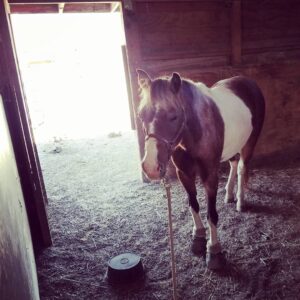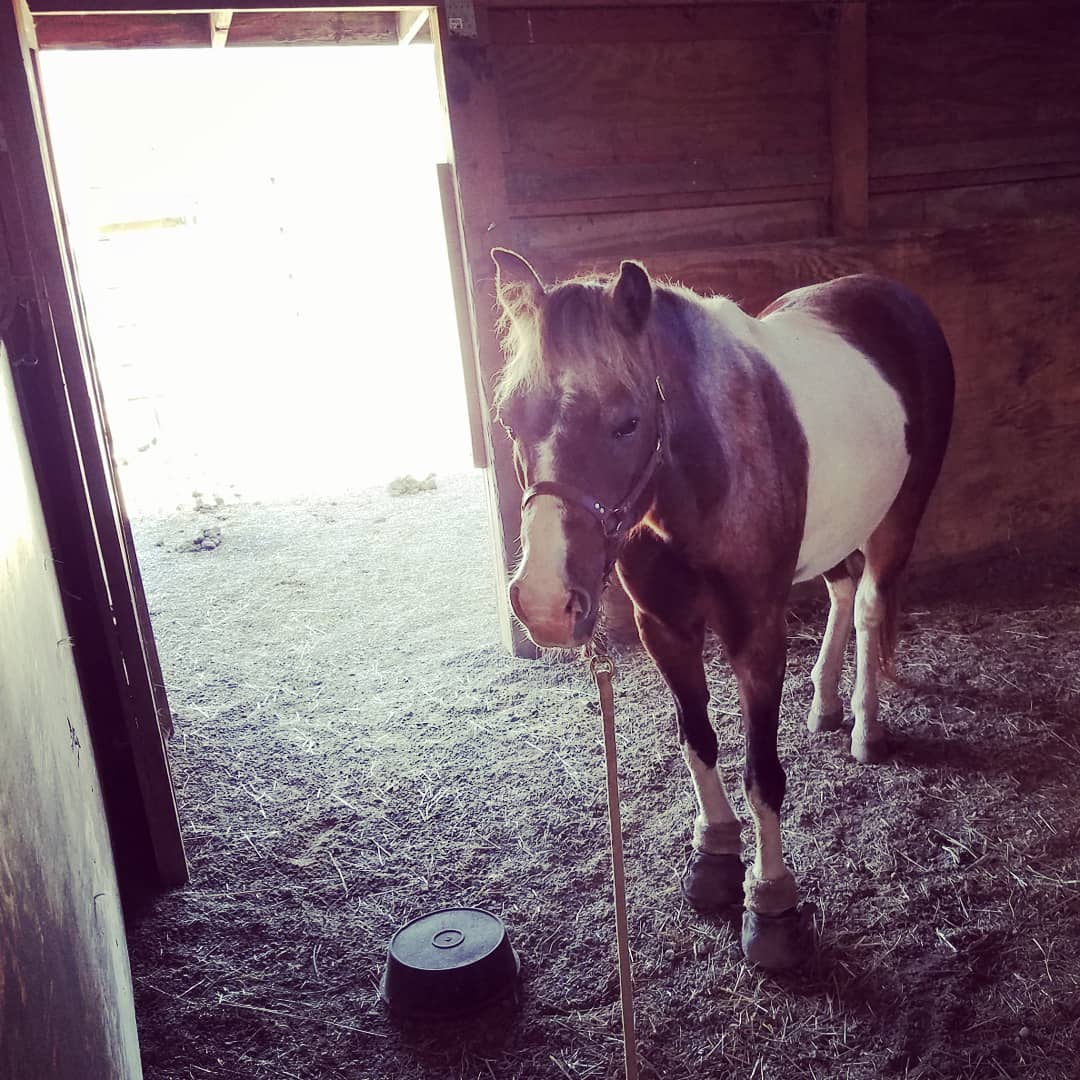For those of you who know my miracle-pony Toby, I just wanted to share how WELL he is doing lately! After a nearly catastrophic neck injury 6 years ago, he made an almost 100% recovery until he foundered last year… so my mission has been to learn about founder in horses, and how to treat it, naturally.

And it has felt like a really uphill battle helping him come back from foundering –
until recently!
Last month, for the first time this year, his hooves actually looked good 4 weeks after his last trim – instead of all long and contracted heels, bulging sole and huge laminar wedge…
And he’s also feeling much better, to the point he was trotting and cantering around my track yesterday (albeit in boots).
So I wanted to share with you what I’ve been doing to manage his pain, just in case you are dealing with laminitis or founder cases too. I hope not!
What is Founder in Horses?
Founder in horses is the extreme version of Laminitis in horses. Laminitis, in it’s most simple terms, literally means “inflammation of the laminae.” While it often includes some inflammation, Laminitis is actually caused by reduced blood flow inside the hoof to the velcro-like tissue between the inner hoof wall and the coffin bone.
Or maybe inflammatory substances in the bloodstream cause the initial damage, which then causes the blood flow to be restricted, setting off the initial ‘acute’ stage of the disease. Research is ongoing on this chicken-or-egg point. (Lameness p629-31)
Acute Laminitis is within the first 72 hours of lameness. After that, it’s referred to as Chronic Laminitis, fyi.
Acute Laminitis can be caused by all sorts of different things, like:
- too much sugar in the horse’s feed or in spring/fall grass
- a toxin that the horse eats from a poisonous plant or spoiled/moldy feed
- endotoxemia caused by colic, Potomac Horse Fever, pneumonia, GI issues, endometriosis
- stress or shock from trauma, over-working on hard footing, extreme dehydration, changes in weather or diet or living situations
- metabolic/pituatary gland issues, usually in older horses
- medications with corticosteroids (like Dexamethasone)
Recognizing Acute Laminitis is pretty easy, as the horses will be very VERY reluctant to move. They typically stand on the backs of their hooves as if they are leaning backward, and will have a strong digital pulse in the affected feet. It’s usually pretty tough to feel the pulse on the inside of a horse’s fetlock, so if you feel it strong and steady, check their feet.
In addition to being painful (ever smashed a finger or toe and had swelling under your nail? Like that, only waaaaay worse) the lack of blood flow and inflammation damages the tissue at the cellular level. This weakens the velcro-effect of the sensitive laminae. When enough of the ‘velcro’ is weakened or damaged, the hoof capsule starts to detach from the pedal bone inside the foot, and it ‘rotates’ or ‘sinks.’ Once the rotation happens, it’s not called Laminitis anymore, and instead is referred to as Founder in horses.
What is Hoof Rotation in a Foundered Horse?
Once the laminae is damaged and the connection between the hoof wall and the pedal bone is weakened or ruptured, there are two major forces at play that cause the dreaded ‘rotation.’
- Tension from the deep digital flexor tendon. The DDFT is attached at the back of the pedal bone inside the hoof, and is connected to the strong flexor muscles of the limb at the other end. This pulls the bone back, away from the hoof wall.
- Walking, especially if the hoof is overgrown or even due for a trim, causes enormous shearing pressure as the weight of the whole horse is bearing down on the hoof wall. The ground then pushes up against the toe of the hoof, pulling it away from the damaged and very sensitive laminae on the inside of the hoof wall. Ouch.
Most vets and texts on hoof anatomy and laminitis refer to the Pedal Bone (aka coffin bone or P3) as being what rotates inside the hoof, but my experience tells me that it’s actually more accurate to describe it as the hoof capsule rotating around the bone. When you look at X-rays of hooves with rotation, you will see that the pedal bone is still in it’s place at the end of the horses leg. The hoof structures are the ones that are distorted and all out of place.
Knowing what caused the laminitis is important for helping you to remove the source so that the horse doesn’t keep triggering more and more inflammation. But other than a vet-diagnosed metabolic issue that can be treated with medication, all the other kinds of laminitis can be treated more or less the same way.
Can a Horse Recover from Founder?
Yes, but you have to catch it early! Most vets will give a very guarded prognosis for a horse suffering from Acute Laminitis ever returning to performance level work. With prompt care and consistent attention, some horses make a full recovery when there isn’t too much damage done inside the hoof.
Other horses develop chronic hoof issues from permanent damage to the blood supply for the hoof wall, and must be managed carefully. Once a horse gets laminitis, they are predisposed to future attacks. Many horses are put down because their pain can not be managed, or they do not recover.
I believe that there is hope, but that we must act quickly if we are going to give our horses the best chance of a full recovery. It’s important that we do everything possible in the acute phase to minimize the damage…
Typical Treatments for Laminitis or Founder in Horses
The first thing you should always do is consult with your vet! Please don’t rely on the internet to ‘self-diagnose’ your horse, at least not without also having your vet check out your horse and offer an expert opinion about what is going on…
In my experience, in the acute phase of laminitis, we are usually told to confine the horse, support the feet, and administer NSAIDS (pain-killers) like Bute or Banamine. Topical application and injections of DMSO, and blood-flow increasing medications are sometimes used too. None are without side-effects.
Why I choose to avoid NSAIDs
Here’s a direct quote from the epic book Lameness: Recognizing And Treating The Horse’s Most Common Ailment written by the two vets Christine King and Richard Mansman: “All NSAIDS have the potential to cause ulcers and kidney damage if given at high doses for several days.”
I will state for the record that I did give my Toby-pony both Bute and Banamine in his initial days of being in pain – to the point he was spending part of every day lying down to get off his hurting feet. The painkillers definitely helped in those early days, but if I had to do it over again, I would start giving some of the complimentary natural remedies (see below) earlier, so that I could make a smoother transition off the NSAIDS sooner.
My experience with my personal horses is that every time a vet has prescribed the use of NSAIDS, my horses ended up with stomach pain. So I started looking for alternatives that wouldn’t damage my horses and weren’t toxic to my kids and students around the barn.
10 Natural Pain-Management Treatments for Founder in Horses
So, here are my top 10 alternative ways to help manage pain w/o NSAIDS and support recovery for a laminitis/founder case: (all learned from my personal experience):
- EHS Initial Pick-ups (I teach you how in this video) to relieve tension on the coffin bone from the Deep Digital Flexor tendon and DDF muscles of the legs
- Calendula flowers – a few fresh blossoms and stem per day, fed as a treat (I grow them around my barn, a very hardy and beautiful plant!)
- CBD oil (seems to work best with some THC content. My fave is a 20:1 CBD to THC ratio in olive oil, but I can’t get it anymore) – I gave the human dose several times a day in the acute phase – I put the drops on a fresh calendula blossom and hand-feed it. For my chronic pony, he gets his dose just once a day, and we are dropping back to 4 days per week.
- Soft-ride boots (or soft-ride orthodic pads in other boots) – 24/7 in acute cases, as needed as the horse recovers.
- Balanced hoof trim ASAP, (obviously) with frequent touch-ups between trims to mediate weird shape and growth. In my experience, it is possible to prevent a hoof capsule from rotating (or rotating as much as it might), even in severe cases, if the hoof is balanced to reduce shearing pressure.
- Cold-soaking feet/legs for 10-20 minutes (1x/hour in acute cases, or as needed) A mud-puddle can work too!
- Feed only organic grass hay and free choice salt (soak the hay for 1-2 hours to remove some of the sugar)
- Light Exercise once the Acute Phase has passed and horse is out of pain (hand-walking on flat ground, wearing boots, even 5-10 mins a day seems to help, but ONLY if the horse is comfortable and willing/able to walk, so not for several weeks in most cases)
- Funky Hoof Vinegar spray to mediate thrush/hoof funk (50/50 cheap white vinegar and water) applied daily
- Loving Massage to stimulate circulation and dopamine release from the connection and attention
Other treatments that personal friends and clients have recommended or used successfully to support a foundered horse, but that I did not find particularly effective in my case, include: devils claw, turmeric/golden blend, and essential oils.
I have also read that NTG (nitroglycerine) patches used in the treatment of human heart patients has been successful at increasing blood flow to the feet and supporting a speedy recovery.
I encourage you to share your experience with these remedies, or others you have found useful, in the comments below! I believe that some horses may respond differently to different herbs or alternative treatments, and it is worth experimenting (safely) to find the combination that works best to support your individual horse.


